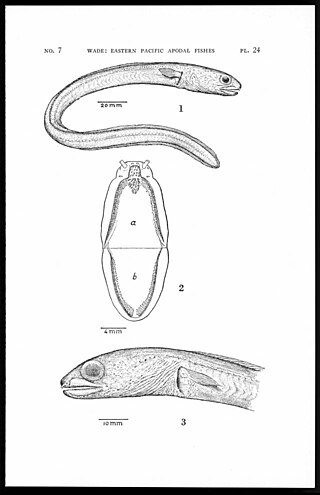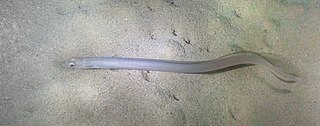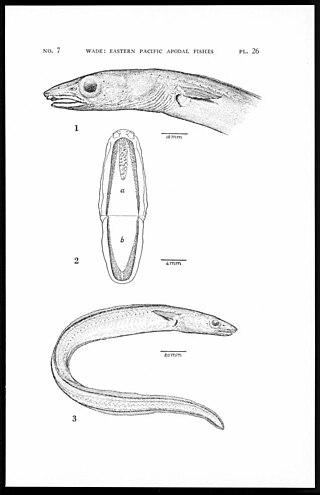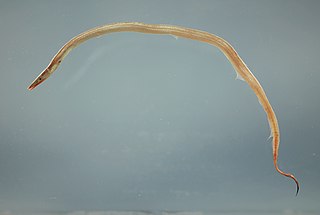
Cynoponticus is a small genus of eels found throughout the Indo-Pacific. It is one of four genera in the family Muraenesocidae. It currently has three described species, which were formerly in the genus Muraenesox. Members are found in a wide distribution of the Atlantic Ocean, Pacific and Indian Oceans. They may be found in the west part of the Mediterranean Sea as well. They do not typically guard their young.

The shorttail conger is an eel in the family Congridae. It was described by Charles Barkley Wade in 1946, originally under the genus Chiloconger. It is a subtropical, marine eel which is known from the eastern and southeastern Pacific Ocean, including Costa Rica, Ecuador, El Salvador, Guatemala, Honduras, Mexico, Nicaragua, the Galapagos Islands, Panama, and Revillagigedo. It dwells at a depth range of 108–150 metres. Males can reach a maximum total length of 30 centimetres.

The bandtooth conger, also known as the Baleares conger or the Balearic conger, is an eel in the family Congridae. It was described by François Étienne Delaroche in 1809, originally under the genus Muraena. It is a subtropical, marine eel which is known from the western and eastern Atlantic and the western Indian Ocean, including North Carolina, United States; the northern Gulf of Mexico, northern South America, Canada, Portugal, Angola, the Mediterranean, and the Red Sea. It inhabits reefs and littoral shelves, and burrows into sand and mud. It dwells at a depth range of 1–732 meters (3–2,402 ft), but most frequently between 20–100 m (66–328 ft). Males can reach a maximum total length (TL) of 35 centimetres, but more commonly reach a TL of 25 centimetres (9.8 in)
The Gilbert's garden eel, also known as the Gilbert's conger and the sharpnose conger, is an eel in the family Congridae. It was described by James Douglas Ogilby in 1898, originally under the genus Congrellus. It is a tropical, marine eel which is known from the eastern central and southeastern Pacific Ocean, including the Gulf of California, Costa Rica, El Salvador, Ecuador, Guatemala, Mexico, Honduras, Nicaragua, Panama, and Colombia. It is a benthic and nocturnal species, and inhabits sand flats in reefs, bays and coves at a depth range of 1–100 metres. It burrows into sand during the day and emerges to forage during the night. Males can reach a maximum total length of 27 centimetres.
The slope conger, also known as the black-fin conger, is an eel in the family Congridae. It was described by Charles Henry Gilbert in 1891, originally under the genus Ophisoma. It is a marine, deep water-dwelling eel which is known from the southeastern and eastern central Pacific Ocean, including Colombia, Ecuador, Costa Rica, Honduras, El Salvador, Mexico, Guatemala, Nicaragua, Panama, and Peru. It is known to dwell at a depth range of 380–740 metres, and inhabits substrates. Males can reach a maximum total length of 35 centimetres.
The shortsnout conger, also known as the thicklip conger, is an eel in the family Congridae. It was described by Samuel Garman in 1899, originally under the genus Atopichthys. It is a tropical, marine eel which is known from the eastern central Pacific Ocean, including Colombia, Costa Rica, Ecuador, El Salvador, Guatemala, Honduras, Mexico, Nicaragua, and Panama. It leads a reclusive, benthic, burrowing lifestyle, and typically dwells at a depth range of 27–2198 metres. Males can reach a maximum total length of 30 centimetres.
The Californian conger, also known as the ringeye conger, is an eel in the family Congridae. It was described by Robert H. Kanazawa. It is a tropical, marine eel which is known from the eastern central and southeastern Pacific Ocean, including Colombia, Costa Rica, Ecuador, El Salvador, Guatemala, Honduras, Mexico, Nicaragua, Panama, and Peru. It is known to dwell at a depth of 50 metres. Males reach an average total length of 40 centimetres, but can reach a maximum TL of 60 cm.
Acromycter alcocki is an eel in the family Congridae. It was described by Charles Henry Gilbert and Frank Cramer in 1897, originally under the genus Promyllantor. It is a marine, deep water-dwelling eel which is known from Hawaii, in the eastern central Pacific Ocean. It dwells at a depth range of 388–640 metres. Males can reach a maximum total length of 25.3 centimetres.
The shorthead conger is an eel in the family Congridae. It was described by Charles Henry Gilbert in 1891, originally under the genus Ophisoma. It is a marine, deep water-dwelling eel which is known from the Gulf of California to Panama, in the eastern central Pacific Ocean. It dwells at a depth range of 265–590 metres. Males can reach a maximum total length of 25 centimetres.
The neighbor conger is an eel in the family Congridae. It was described by Samuel Garman in 1899, originally under the genus Uroconger. It is a marine, deep water-dwelling eel that is known from the southwestern and western central Atlantic Ocean, including the Bahamas, Brazil, Cuba, and Mexico. It dwells at a depth range of 101–503 metres. Males can reach a maximum total length of 46.2 centimetres.

The large-toothed conger is an eel belonging to the family Congridae. It was described by Léon Vaillant in 1888, originally as a species of the genus Uroconger.
Gnathophis bracheatopos, the longeye conger, is an eel in the family Congridae. It was described by David G. Smith and Robert H. Kanazawa in 1977. It is a tropical, marine eel which is known from the United States and the eastern Gulf of Mexico, in the western Atlantic Ocean. It dwells at a depth range of 55–110 meters. Males can reach a maximum total length of 35 centimeters.

Gnathophis cinctus, the hardtail conger or Catalina conger, is an eel in the family Congridae. It was described by Samuel Garman in 1899, originally under the genus Atopichthys. It is a tropical, marine eel which is known from the eastern central and southeastern Pacific Ocean, including Chile, Colombia, Costa Rica, Ecuador, El Salvador, Guatemala, Honduras, Mexico, Nicaragua, Panama, Peru, and the United States. It dwells at a depth range of 9–336 metres, and leads a benthic lifestyle, burrowing into loose sand. Males can reach a maximum total length of 42 cm.
The whiptail conger, also known as the conger eel in Cuba, is an eel in the family Congridae. It was described by Isaac Ginsburg in 1951, originally under the genus Congrina. It is a marine, deep water-dwelling eel which is known from the western Atlantic Ocean, including the United States in the northern Gulf of Mexico and northern South America. It is known to dwell at a depth of 203 meters (666 ft). Males can reach a maximum total length of 61 centimeters (24 in).
The bignose conger is an eel in the family Congridae. It was described by David Starr Jordan and Charles Harvey Bollman in 1890. It is a tropical, marine eel which is known from the eastern central and southeastern Pacific Ocean, including Chile, Colombia, Costa Rica, Ecuador, El Salvador, Guatemala, Honduras, Mexico, Nicaragua, Panama, and Peru. It dwells at a depth range of 25–90 metres. Males can reach a maximum total length of 40 centimetres, but more commonly reach a TL of 30 cm.
The white-ring garden eel, also known as the Cape garden eel in Mexico, is an eel in the family Congridae. It was described by Garry I. McTaggart-Cowan and Richard Heinrich Rosenblatt in 1974, originally under the genus Taenioconger. It is a marine, tropical eel which is known from the Gulf of California, in the eastern central Pacific Ocean. It is known to dwell at a depth of 20 m (66 ft), and inhabits sand sediments near reefs, where it forms burrows in nonmigratory colonies. Males can reach a maximum total length of 80 cm.
The pale green eel, also known as the pale garden eel or the Cortez garden eel, is an eel in the family Congridae. It was described by Jacques Pellegrin in 1923, originally under the genus Taenioconger. It is a nonmigratory marine, deepwater-dwelling eel which is known from the eastern central Pacific Ocean, including the Gulf of California and Mexico. It dwells at a depth of 230 to 275 m and inhabits sandy sediments near reefs in large colonies. Males can reach a maximum total length of 63 cm.

The freckled pike-conger, also known as the silver conger, is an eel in the family Nettastomatidae. It was described by Isaac Ginsburg in 1951. It is a marine, subtropical eel which is known from the western central Atlantic Ocean, including the Gulf of Mexico, Colombia, and towards the mouth of the Amazon River. It dwells at a depth range of 55–310 meters. Males can reach a maximum total length of 54.2 centimeters.
The smiling snake eel is an eel in the family Ophichthidae. It was described by David Starr Jordan and Charles Henry Gilbert in 1882, originally under the genus Apterichthys. It is a marine, tropical eel which is known from the eastern central and southeastern Pacific Ocean, including Colombia, Costa Rica, Panama, Ecuador, and Mexico. It dwells at a maximum depth of 30 metres (98 ft), and inhabits sediments of sand. Males can reach a maximum total length of 41 centimetres (16 in).
The yellow snake eel is an eel in the family Ophichthidae. It was described by David Starr Jordan and Charles Henry Gilbert in 1882. It is a marine, subtropical eel known from the eastern central and southeastern Pacific Ocean, including Chile, Costa Rica, Colombia, Ecuador, Guatemala, El Salvador, Honduras, Nicaragua, Mexico, Panama, Peru, and the United States. It dwells at a depth range of 1 to 110 m, and forms burrows in rocky and sandy regions. Males can reach a maximum total length of 818 cm (322 in), but more commonly reach a length of 540 cm (210 in).







